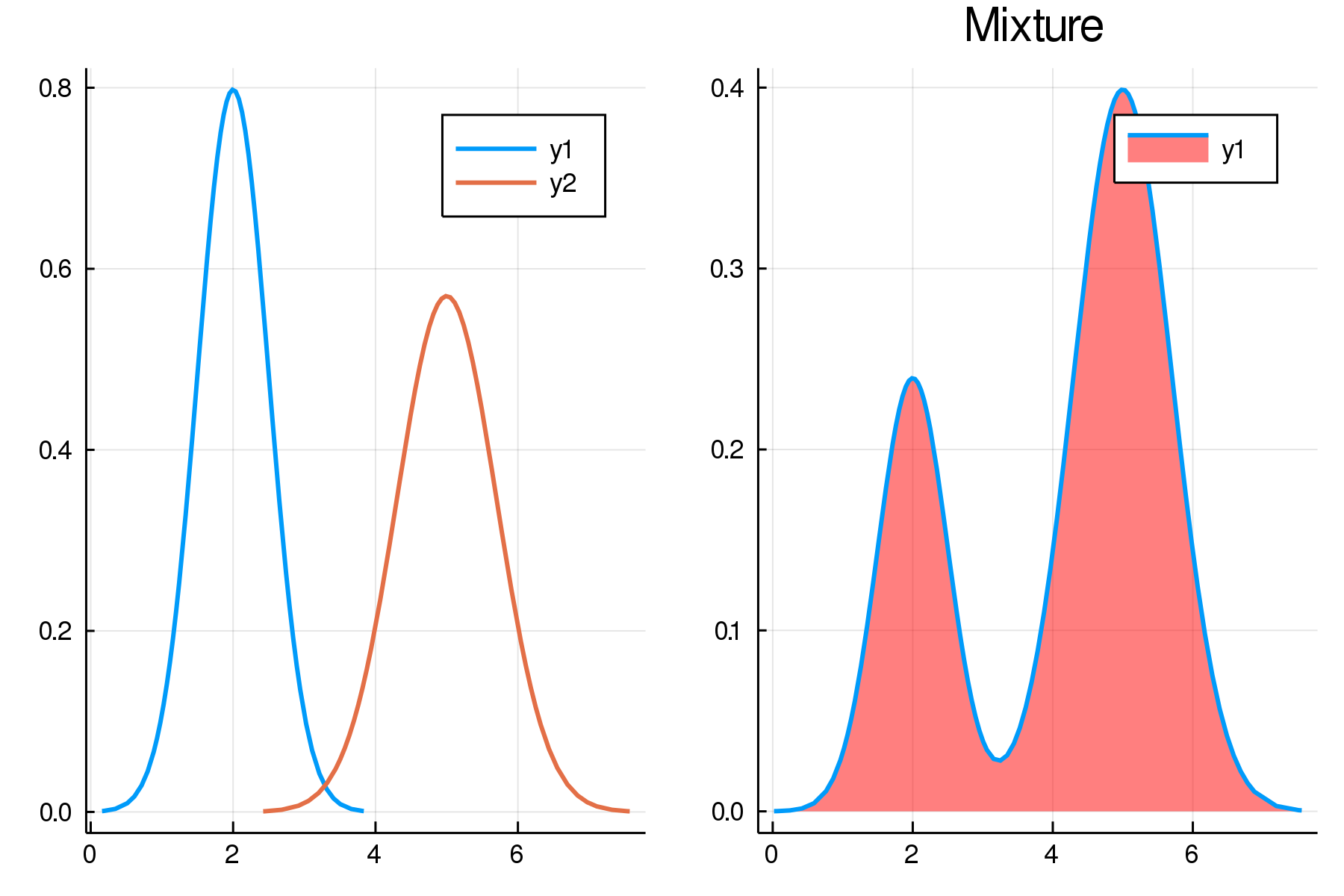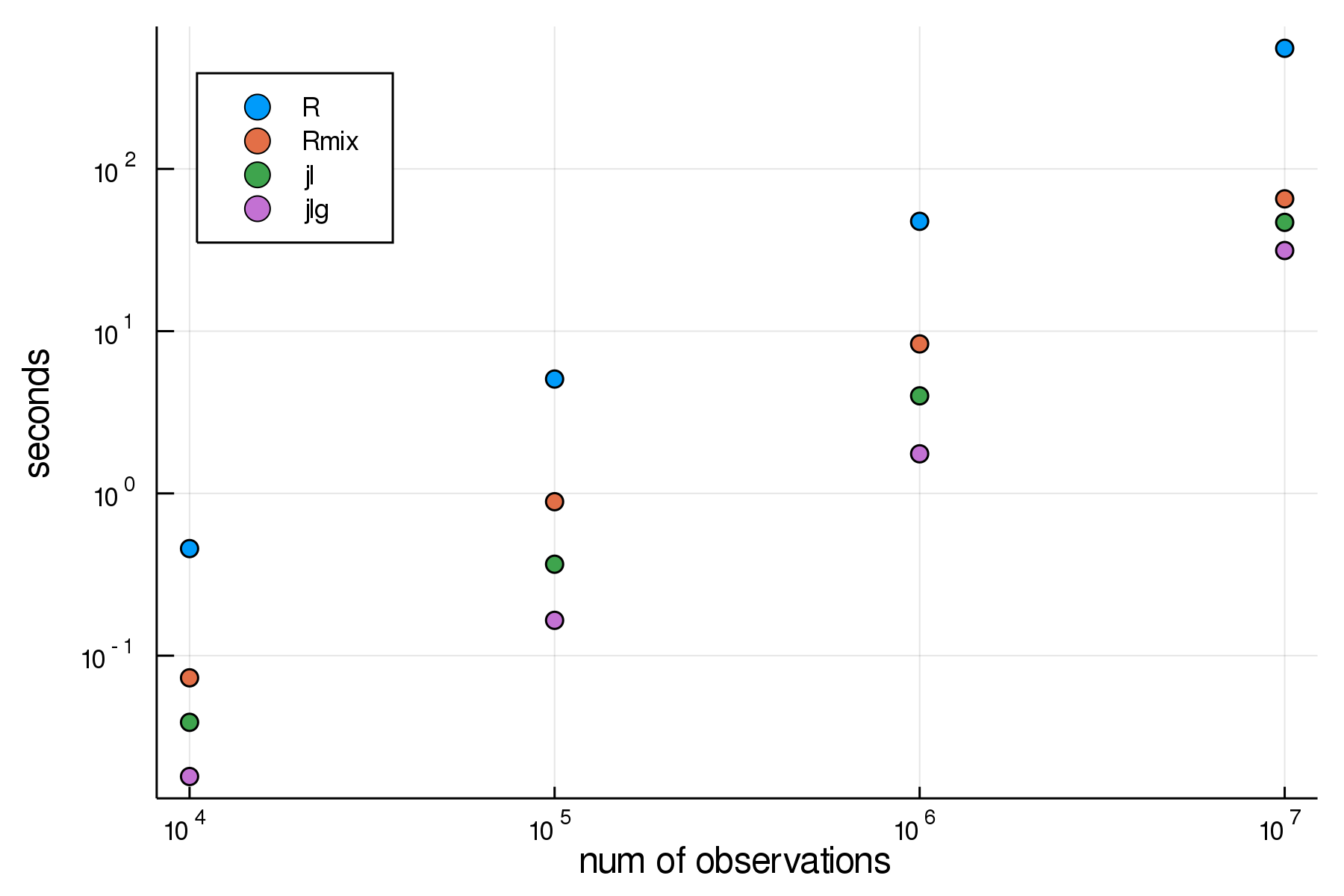EM Benchmarks
I am getting into estimating mixture models at the moment. In particular in the context of models of wage formation where unobserved heterogeneity stemming from both firm and worker side is often modeled with a mixture model. The main assumptions are that
- Firms are classifiable into types $l \in \{1,\dots,L\}$, workers into $k \in \{1,\dots,K\}$
- If Worker $i$ is of type $k$ and works for firm $l$ in a certain period, their wages are drawn from distribution $\mathcal{N}(\mu_{k,l},\sigma_{k,l})$.
This kind of model is at the current frontier of econometrics, and a recent paper is Bonhomme, Lamadon and Manresa (Econometrica 2019), ungated here, with a great replication package in R.
The estimation of such models often involves using the EM-Algorithm, which I won’t describe in detail here.
Weapon of Choice?
Now before getting to the full model above, I wanted to know my options in terms of programming language. I decided to benchmark a simple version of the above problem: there is only one firm type (all workers at the same firm), and there are only two worker types, $K=2$. I am considering two options in terms of language: R and julia.
I’ll do a hand-coded version in each language, as well as use a package from each:
- Hand-coding is relevant because my final problem will need some modification of existing algorithms.
- Packages are relevant because they often provide efficient implementations, and could be the building block on which my extension is based.
Here goes!
Benchmark Setup
I will benchmark everything out of a julia session by relying on the RCall.jl package (benchmark code on this repo). RCall.jl launches an R session from within julia and allows to go back and forth with surprisingly little overhead (accesses the same locations in RAM, so no data is copied). The advantage of this is that I can create the exact same benchmarking data to test in both languages. So all code you see here is valid julia, even though sometimes it contains some R. Cool, right?🕺
Here is the data creator:
function sdata(k,n; doplot = false)
Random.seed!(3333)
# true values
μ = [2.0,5.0]
σ = [0.5,0.7]
α = [0.3,0.7]
m = MixtureModel([Normal(μ[i], σ[i]) for i in 1:2], α)
if doplot
plot(
plot(m,linewidth=2),
plot(m,linewidth=2, fill=(0,:red,0.5), components = false, title="Mixture"),dpi = 300
)
savefig("mixtures.png")
end
y = rand(m,n)
return Dict(:y => y, :μ => μ, :σ => σ, :α => α)
end
- sets true mixture parameters
- creates a
Distributions.MixtureModeldata type - optionally makes a plot from it
- draws
nrandom realizations from it
The setup looks like this:

All benchmarks will now proceed in the same way:
- Take vector
y - set (the same) wrong starting values
- run the EM algorithm for
itersiterations to find true values of proportion weights $\alpha$, means $\mu$ and variances $\sigma$ for each component. - Notice that the starting values are such that the algorithm never fully recovers the true values. Given it’s the same data, however, each implementation will follow the same path for parameter values and run the same number of iterations (again, none until convergence).
julia by hand
Here is my relatively naive and just-copy-thy-math implemenation in julia:
function bm_jl(y::Vector{Float64};iters=100)
# poor starting values
μ = [4.0,6.0]
σ = [1.0,1.0]
α = [0.5,0.5]
N = length(y)
K = length(μ)
# initialize objects
L = zeros(N,K)
p = similar(L)
for it in 1:iters
dists = [Normal(μ[ik], σ[ik] ) for ik in 1:K]
# evaluate likelihood for each type
for i in 1:N
for k in 1:K
# Distributions.jl logpdf()
L[i,k] = log(α[k]) + logpdf.(dists[k], y[i])
end
end
# get posterior of each type
p[:,:] = exp.(L .- logsumexp(L))
# with p in hand, update
α[:] .= vec(sum(p,dims=1) ./ N)
μ[:] .= vec(sum(p .* y, dims = 1) ./ sum(p, dims = 1))
σ[:] .= vec(sqrt.(sum(p .* (y .- μ').^2, dims = 1) ./ sum(p, dims = 1)))
end
return Dict(:α => α, :μ => μ, :σ => σ)
end
GaussianMixtures.jl
Next is a julia package written for this purpose. Here is the relevant part:
function bm_jl_GMM(y::Vector{Float64};iters=100)
gmm = GMM(2,1) # initialize an empty GMM object
# stick in our starting values
gmm.μ[:,1] .= [4.0;6.0]
gmm.Σ[:,1] .= [1.0;1.0]
gmm.w[:,1] .= [0.5;0.5]
# run em!
em!(gmm,y[:,:],nIter = iters)
return gmm
end
R not-so-naive by hand
- I tried to vectorize as much as possible here
- Self-imposed rules: no
Rcpp - You can see this uses an
R-string, where data values are interpolated with a$into theRsession.
# this is a julia function!
function bm_R(y;iters=100)
# that defines an R-string, sent off to R.
r_result = R"""
library(tictoc)
# define a `repeat` function
spread <- function (A, loc, dims) {
if (!(is.array(A))) {
A = array(A, dim = c(length(A)))
}
adims = dim(A)
l = length(loc)
if (max(loc) > length(dim(A)) + l) {
stop("incorrect dimensions in spread")
}
sdim = c(dim(A), dims)
edim = c()
oi = 1
ni = length(dim(A)) + 1
for (i in c(1:(length(dim(A)) + l))) {
if (i %in% loc) {
edim = c(edim, ni)
ni = ni + 1
}
else {
edim = c(edim, oi)
oi = oi + 1
}
}
return(aperm(array(A, dim = sdim), edim))
}
# define row-wise logsumexp
logRowSumExp <- function(M) {
if (is.null(dim(M))) {return(M)}
vms = apply(M,1,max)
log(rowSums(exp(M-spread(vms,2,dim(M)[2])))) + vms
}
# define the function to be timed in R
simpleEM <- function(y,iters){
K = 2
N = length($y)
EMfun <- function(mu,sigma,alpha,iters){
# allocate arrays
p = array(0,c(N,K))
L = array(0,c(N,K))
for (it in 1:iters){
# E step
# vectorized over N loop
for (k in 1:K){
L[ ,k] = log(alpha[k]) + dnorm(y,mean = mu[k], sd = sigma[k], log = TRUE)
}
p = exp(L - logRowSumExp(L))
# M step
alpha = colMeans(p)
mu = colSums(p * y) / colSums(p)
sigma = sqrt( colSums( p * (y - spread(mu,1,N))^2 ) / colSums(p) )
}
o =list(alpha=alpha,mu=mu,sigma=sigma)
return(o)
}
# starting values
mu_ = c(4.0,6.0)
sigma_ = c(1.0,1.0)
alpha_ = c(0.5,0.5)
# take time
tic()
out = EMfun(mu_,sigma_,alpha_,iters)
tt = toc()
return(list(result = out, time = tt$toc - tt$tic))
}
simpleEM($y,$iters) # run function in R!
"""
return r_result
end
R mixtools package
The mixtools package is a very mature and highly optimized package for EM estimation. Most of the computationally intensive parts are written in C^[For example, in the package source, look for src/normpost.c which evaluates the matrix of posterior probabilities, object p in the julia code above. ]. My call:
function bm_R_mixtools(y::Vector{Float64};iters=100)
r_result = R"""
library(tictoc)
library(mixtools)
mu = c(4.0,6.0)
sigma = c(1.0,1.0)
alpha = c(0.5,0.5)
y = $y
N = length(y)
K = 2
iters = $iters
tic()
result = normalmixEM(y,k = K,lambda = alpha, mu = mu, sigma = sigma, maxit = iters)
tt = toc()
list(result = result, time = tt$toc - tt$tic)
"""
return r_result
end
Results!
- I use the
BenchmarkTools.jlpackage to benchmark the julia functions. This runs the functions multiple times to account for system noise. (running multiple times also gets rid of any JIT-related delays in julia) - The
Rfunctions are timed within the R process using thetictocpackage, so even if there were any significant overhead fromRCall.jl, the measurement is immune to that.
Here is the output table, with n for sample size, and times in seconds:
| n | jl | jlg | R | Rmix |
|---|---|---|---|---|
| 10000 | 0.0388268 | 0.0179957 | 0.457 | 0.073 |
| 100000 | 0.366047 | 0.16506 | 5.068 | 0.889 |
| 1000000 | 3.99279 | 1.75384 | 47.522 | 8.344 |
| 10000000 | 46.833 | 31.4021 | 553.783 | 65.379 |
And a much clearer picture using log scales:

Conclusions
- The naively hand-written code in
juliaperforms very well. - The
GaussianMixtures.jlperforms best throughout - Both julia implementations outperform the
C-optimizedR mixtoolspackage. - The vectorized
Rversion comes in slowest.
I take from this that focusing on extending the work in GaussianMixtures.jl for my purposes is the most promising avenue here.
Code and Versions
Code is on github with full package version manifest.
julia> versioninfo()
Julia Version 1.1.0
Commit 80516ca202 (2019-01-21 21:24 UTC)
Platform Info:
OS: macOS (x86_64-apple-darwin14.5.0)
CPU: Intel(R) Core(TM) i5-5257U CPU @ 2.70GHz
WORD_SIZE: 64
LIBM: libopenlibm
LLVM: libLLVM-6.0.1 (ORCJIT, broadwell)
shell> R --version
R version 3.5.1 (2018-07-02) -- "Feather Spray"
Copyright (C) 2018 The R Foundation for Statistical Computing
Platform: x86_64-apple-darwin15.6.0 (64-bit)
R is free software and comes with ABSOLUTELY NO WARRANTY.
You are welcome to redistribute it under the terms of the
GNU General Public License versions 2 or 3.
For more information about these matters see
http://www.gnu.org/licenses/.